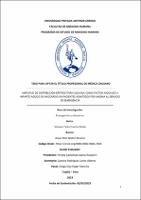Mostrar el registro sencillo del ítem
Amplitud de distribución eritrocitaria elevada como factor asociado a infarto agudo de miocardio en pacientes admitidos por angina al servicio de emergencia
| dc.contributor.advisor | Llique Díaz, Walter Nicanor | |
| dc.contributor.author | Vásquez Soto, Franzia Paola | |
| dc.creator | Vásquez Soto, Franzia Paola | |
| dc.date.accessioned | 2023-05-05T13:48:09Z | |
| dc.date.available | 2023-05-05T13:48:09Z | |
| dc.date.issued | 2023 | |
| dc.identifier.uri | https://hdl.handle.net/20.500.12759/10679 | |
| dc.description.abstract | Muchos pacientes acuden a la Emergencia por angina, siendo insuficiente la clínica para identificar a aquellos que evolucionarán a Infarto Agudo de Miocardio (IAM). Las enzimas cardiacas requieren de un período de tiempo para establecer el diagnóstico y los cambios electrocardiográficos no son siempre específicos. La elevada mortalidad asociada al IAM hace necesario proponer métodos más rápidos y sencillos para poder predecir qué pacientes se encuentran en mayor riesgo de sufrirlo. Objetivo: Establecer si la amplitud de distribución eritrocitaria (ADE) elevada es un factor asociado al IAM en pacientes admitidos por angina al servicio Emergencia. Material y método: Se realizó un estudio de casos y controles entre enero del 2017 a diciembre del 2020. Se evaluaron 336 historias clínicas de pacientes admitidos por angina al Servicio de Emergencia del Hospital Víctor Lazarte Echegaray: 112 casos (pacientes con angina que desarrollaron IAM) y 224 controles (pacientes con angina que no desarrollaron IAM). Se aplicó la prueba de Chi cuadrado para medir asociación entre las variables. Posteriormente, para el análisis bivariado se calculó el Odds Ratio (OR) y el análisis multivariado se realizó mediante regresión logística para el estudio de las covariables, todos con el mismo criterio de significación estadística (p<0,05). Resultados: El ADE elevado estuvo presente en 73,2% de los casos y en el 3,1% de los controles, representando el factor independiente con mayor asociación a la evolución a IAM después de ajustar las variables de confusión (p = 0,000; OR 53,28: IC 95% 8,71 – 325,9). Conclusiones: La amplitud de distribución eritrocitaria elevada es un factor asociado a infarto agudo de miocardio. Se recomienda su uso como biomarcador para estratificar el riesgo de desarrollar IAM entre los pacientes admitidos por angina a Emergencia. | es_PE |
| dc.description.abstract | Many patients come to the Emergency Service due to angina, the clinical picture being insufficient to identify those who will evolve to Myocardial Infarction (MI). Cardiac enzymes require a period of time to establish the diagnosis and electrocardiographic changes are not always specific. The high mortality associated with MI requires to propose faster and simpler methods to be able to predict which patients are at higher risk of suffering from it. Objective: To establish whether the elevated red blood cell distribution width (RDW) is a factor associated with MI in patients admitted for angina to the Emergency service. Material and method: A case-control study was carried out between January 2017 and December 2020. 336 medical records of patients admitted for angina to the Emergency Service of the Víctor Lazarte Echegaray Hospital were evaluated: 112 cases (patients with angina who developed AMI ) and 224 controls (patients with angina who did not develop AMI). The Chi square test was applied to measure the association between the variables. Subsequently, for the bivariate analysis the Odds Ratio (OR) was calculated and the multivariate analysis was performed using logistic regression to study the covariates, all with the same criterion of statistical significance (p <0.05). Results: The elevated RDW was present in 73.2% of the cases and in 3.1% of the controls, representing the independent factor with the greatest association with the evolution to MI after adjusting the confounding variables (p = 0.000; OR 53.28: IC 95% 8.71 – 325.9). Conclusions: The elevated red cell distribution width is a factor associated with myocardial infarction. Its use as a biomarker is recommended to stratify the risk of developing MI among patients admitted for emergency angina. | en_US |
| dc.description.uri | Tesis | es_PE |
| dc.format | application/pdf | es_PE |
| dc.language.iso | spa | es_PE |
| dc.publisher | Universidad Privada Antenor Orrego | es_PE |
| dc.relation.ispartofseries | T_MED_3422 | |
| dc.rights | info:eu-repo/semantics/closedAccess | es_PE |
| dc.rights.uri | https://creativecommons.org/licenses/by/4.0/ | es_PE |
| dc.source | Universidad Privada Antenor Orrego | es_PE |
| dc.source | Repositorio institucional - UPAO | es_PE |
| dc.subject | Angina | es_PE |
| dc.subject | Amplitud de Distribución Eritrocitaria | es_PE |
| dc.title | Amplitud de distribución eritrocitaria elevada como factor asociado a infarto agudo de miocardio en pacientes admitidos por angina al servicio de emergencia | es_PE |
| dc.type | info:eu-repo/semantics/bachelorThesis | es_PE |
| thesis.degree.grantor | Universidad Privada Antenor Orrego. Facultad de Medicina Humana | es_PE |
| thesis.degree.name | Medico Cirujano | es_PE |
| thesis.degree.discipline | Medicina | es_PE |
| dc.subject.ocde | http://purl.org/pe-repo/ocde/ford#3.02.27 | es_PE |
| renati.advisor.orcid | https://orcid.org/0000-0002-8606-2506 | es_PE |
| renati.author.dni | 75419201 | |
| renati.advisor.dni | 17974001 | |
| renati.type | http://purl.org/pe-repo/renati/type#tesis | es_PE |
| renati.level | http://purl.org/pe-repo/renati/level#tituloProfesional | es_PE |
| renati.discipline | 912016 | es_PE |
| renati.juror | Peralta Castañeda, Idania Rosalynn | |
| renati.juror | Zamora Rodríguez, Carlos Alberto | |
| renati.juror | Aliaga Díaz, Roger Marcilio | |
| dc.publisher.country | PE | es_PE |
Ficheros en el ítem
Este ítem aparece en la(s) siguiente(s) colección(es)
-
Medicina Humana [2765]


